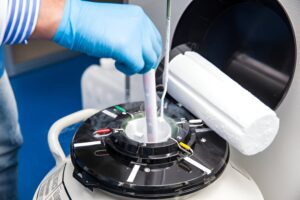COPD Stem Cell Therapy
Contents
In chronic obstructive pulmonary disease, breathing becomes challenging in people with a lung disorder that worsens over time. Research says, over 16.4 million people have been diagnosed with this illness.
Also, an additional 18 million people are estimated to be living with COPD but are unaware of it. The two main kinds of COPD are emphysema and chronic bronchitis. Many COPD sufferers have both.

Image Credit: https://www.istockphoto.com/photo/visiting-senior-gm1302678517-394349132
Currently, there is no treatment for COPD. Only treatments available improve the quality of life and slow the progress of the disease.
However, new research suggests that COPD therapy with stem cells can aid in the treatment of this particular lung condition.
Stem cells are dividing, self-renewing cells that can come from either embryos or adults. Despite not being specialists, they have the potential to become effective and eventually act as cells in different body parts.
Stem cells have the potential to regenerate and can be used to create many cell types, which makes them useful for replacing or repairing damaged tissues. Researchers are interested in using stem cell therapy to address a variety of recurring illnesses.
The extraordinary ability of stem cells to differentiate into any type of bodily cell is known as isolation. They can be given intravenously and identify damaged tissues near organs. Stem cells can restore damaged lung tissue to fight emphysema or chronic bronchitis in COPD patients.
Natural anti-inflammatory components found in stem cells can help people with chronic bronchitis by clearing their airways.
Primary Cause of COPD
COPD is primarily caused by tobacco use, either by passive smoking or active smoking. A person’s bronchial tubes can produce more mucus because of inhaling dust or other airborne irritants or adulterants, which can lead to inflammation in the form of thickened bronchial walls.
Constant coughing and performing in rising mucous are signs of elevated mucus production in the bronchial tubes. When adulterants are consumed in excess, COPD can develop over a lengthy period or suddenly.

Image Credit: https://www.istockphoto.com/photo/patient-inhaling-through-oxygen-mask-gm845311230-138451053
Effects of COPD
- One or more of the following effects in the lungs and airways are brought on by COPD:
- Loss of airway and air sac flexibility.
- The air sacs’ internal walls are broken.
- The lining of the airways thickens and swells.
- The mucus accumulates and congests the airways.
These changes lessen the amount of air that enters and exits the lungs, depriving the body of essential oxygen and making breathing more difficult.
Effect of Stem Cells on COPD
- People with COPD may gain from stem cells by:
- Decreasing airway inflammation helps in preventing future harm.
- Encouraging the creation of new capillaries, which are small blood arteries in the lungs
- Improve lung function by replacing any damaged lung tissue with new, healthy lung tissue.
[irp posts=”914″ ]
General Treatment for COPD
The goals of COPD treatment often include symptom relief, preventing further lung damage, and improving quality of life.
Here are a few examples of how to restore lung injury.
· Medications
Breathing becomes easier because of the use of bronchodilators, corticosteroids, and other particular medications that assist in opening the airways and reduce inflammation.

Image Credit: https://www.istockphoto.com/photo/mature-man-using-asthma-inhaler-gm1224960046-360377285
· Oxygen therapy
Oxygen therapy is important for those with severe COPD, to ensure that the body gets enough oxygen. This can entail using a portable oxygen concentrator or oxygen tank.
· Pulmonary Rehabilitation
For those with COPD, this exercise and education program can assist improve quality of life and physical exertion.
· Surgery
In certain circumstances, surgery may be required to take out the damaged lung tissue or to restore the airway.
· Stem cell treatment
There is some evidence that stem-cell therapy for the lungs can improve lung function and lessen inflammation in persons with COPD. The usefulness of stem cell therapy for COPD is still under investigation, and further research is needed to ascertain its long-term efficacy.

Image Credit: https://www.istockphoto.com/photo/seniors-still-in-love-gm620402312-108269459
According to research, patients with moderate to severe COPD can benefit from allogeneic umbilical cord-derived mesenchymal stem cell transplantation because it is both safe and effective.
Chronic obstructive pulmonary disease (COPD) has no cure, however, medication can help control the symptoms and slow the disease’s development. For the most recent information on the various treatments for their ailment, patients should contact a lung specialist.
In the case of stem cell therapy, patients should find funded clinical trials for COPD or chronic inflammation as the best choice for people with COPD. Enquire about the number of cells included in the treatment regimen and what kind of cells the patient will receive while looking into stem cell clinics for COPD.













Post Comment